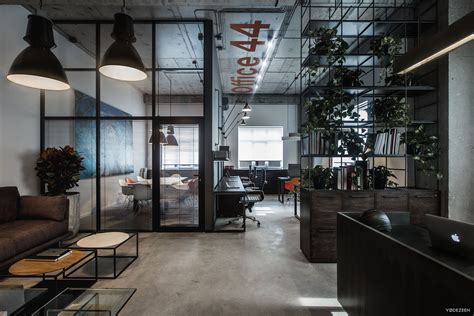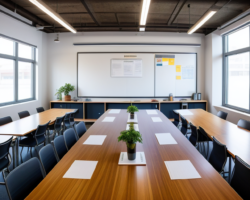Are you looking to transform your workshop or home office into a stylish industrial space? Industrial design has become increasingly popular for its raw, edgy, and functional aesthetic. In this blog post, we will guide you through the process of designing an industrial-style workspace that exudes character and efficiency. From understanding the industrial design aesthetic to selecting the right color palette, furniture, and fixtures, we will cover every aspect of creating a captivating industrial-style environment. We will also delve into optimizing workspace layout for maximum efficiency, incorporating raw materials and exposed elements, and implementing lighting strategies to enhance the industrial vibe. Additionally, we will explore ways to add personal touches and decorative accents that infuse your space with individuality. Whether you’re a creative professional, a DIY enthusiast, or simply appreciate the industrial design aesthetic, this post will provide you with the inspiration and tips you need to revamp your workspace.
Understanding the Industrial Design Aesthetic
Industrial design is a style that emphasizes a raw and unfinished look, taking inspiration from old factories and industrial spaces. This aesthetic is characterized by the use of materials such as metal, concrete, and reclaimed wood, as well as exposed mechanical elements.
When designing an industrial-style space, it is important to understand the key elements that define this aesthetic. One of the main features of industrial design is the use of raw materials like steel, iron, and distressed wood, which adds to the rugged and unfinished look of the space.
Another important aspect of industrial design is the use of exposed elements such as pipes, beams, and ductwork. These elements are left visible to create an authentic industrial feel, reminiscent of old factories and warehouses.
Understanding the industrial design aesthetic also involves paying attention to lighting strategies. Industrial-style spaces often feature industrial-style light fixtures, such as pendant lights with metal shades or vintage-style filament bulbs, to enhance the rugged and utilitarian look of the space.
Choosing the Right Color Palette
When designing an industrial-style space, one of the most important decisions you’ll make is choosing the right color palette. The colors you choose will set the tone for the entire space, and can greatly impact the overall aesthetic. It’s important to consider the type of industrial look you’re going for – whether it’s a more modern, sleek design or a more rustic, vintage look.
When it comes to industrial design, neutral tones are often the go-to choice. Think shades of grey, brown, black, and white. These colors can provide a strong foundation for your space, creating a clean and minimalist look that is characteristic of industrial design. However, don’t be afraid to add a pop of color to add some interest and personality to the space.
Another important factor to consider is how the colors will work with the natural light in the space. If you have large windows that let in a lot of natural light, you’ll want to consider how the colors will look in different lighting conditions. If your space is more dimly lit, you may want to opt for lighter colors to help brighten up the space.
Ultimately, the right color palette for your industrial-style space will depend on a variety of factors, including the look you’re going for, the natural light in the space, and your own personal preferences. Take the time to consider all of these factors, and you’ll be sure to choose a color palette that perfectly complements your industrial design aesthetic.
Selecting the Appropriate Furniture and Fixtures
When it comes to creating an industrial-style space, one of the most important factors to consider is the selection of the appropriate furniture and fixtures. Industrial design aesthetic is known for its utilitarian and minimalist look, so it is crucial to choose pieces that not only complement the overall style but also serve a functional purpose.
One of the key elements to keep in mind when selecting furniture and fixtures for an industrial-style space is to focus on pieces that are made from raw materials such as wood, metal, and concrete. These materials not only add to the rugged and urban look of the space but also provide durability and longevity.
Another important aspect to consider is the size and scale of the furniture and fixtures. Industrial-style spaces are often characterized by their spacious and open layouts, so it is essential to choose pieces that are proportionate to the size of the space. Oversized furniture can overwhelm the space, while undersized pieces can make the room feel empty and uninviting.
Additionally, it is important to select fixtures and furniture that embrace the unfinished look. Exposed pipes, weathered wood, and distressed metal are all common features of industrial-style spaces and can add a sense of authenticity and character to the design.
Optimizing Workspace Layout for Efficiency
When designing an industrial-style workspace, it’s important to consider the layout for maximum efficiency. The workspace layout will impact the productivity and well-being of the employees, as well as the overall functionality of the space. It’s essential to carefully plan the placement of workstations, storage areas, and common areas to create a space that is conducive to productivity.
One of the key factors to consider when optimizing the workspace layout is the flow of movement. Employees should be able to move seamlessly from one area to another without any hindrances. It’s important to ensure that there are clear pathways and that workstations are strategically placed to minimize unnecessary movement. This can be achieved by creating designated zones for different tasks and organizing the layout accordingly.
In addition to the flow of movement, it’s important to consider the placement of equipment and tools within the workspace. The efficiency of the layout can be greatly enhanced by strategically placing the necessary tools and equipment within easy reach of the employees. This can help to streamline workflow and minimize the time spent searching for necessary items, ultimately improving productivity.
Finally, it’s crucial to consider the incorporation of ergonomic design principles when optimizing the workspace layout. By prioritizing the comfort and well-being of the employees, you can create a workspace that is not only efficient but also promotes a healthy and productive environment. This can be achieved by selecting appropriate furniture and fixtures that are designed with ergonomics in mind and ensuring that workstations are set up to support proper posture and movement.
Incorporating Raw Materials and Exposed Elements
When it comes to industrial design aesthetic, incorporating raw materials and exposed elements is a key aspect of creating an authentic and visually compelling space. Raw materials such as wood, metal, and concrete add a sense of rawness and authenticity to the design, while exposed elements like pipes, ducts, and structural elements further emphasize the industrial look.
Choosing to incorporate raw materials and exposed elements into your design can help add character and depth to the space. It can also create a sense of connection to the history and origins of the building or space, as these elements often showcase the structural and functional aspects of the space.
One way to effectively incorporate raw materials and exposed elements is by using them as focal points in the design. Whether it’s an exposed brick wall, a reclaimed wood table, or industrial-style lighting fixtures, these raw materials and elements can serve as statement pieces that anchor the overall aesthetic of the space.
Furthermore, incorporating raw materials and exposed elements can also create a sense of contrast and juxtaposition within the space, adding visual interest and complexity. For example, pairing raw concrete floors with polished metal fixtures or combining weathered wood with sleek glass surfaces can create a dynamic and visually engaging design.
Lighting Strategies for a Industrial-style Space
When it comes to creating the perfect industrial-style space, lighting plays a crucial role in setting the right ambiance and enhancing the overall aesthetic. Industrial-style spaces are known for their raw, unfinished look, and the right lighting strategies can help to highlight these elements while also providing functional illumination.
One effective lighting strategy for an industrial-style space is to incorporate Edison bulbs or exposed filament bulbs. These vintage-style bulbs add a touch of nostalgia and authenticity to the space, while also providing warm, ambient lighting. They can be used in pendant lights, chandeliers, or even as part of exposed bulb fixtures to create a striking visual impact.
Another key consideration when planning the lighting for an industrial-style space is to make use of metal fixtures and industrial-style lighting designs. Industrial-style lighting often features raw materials such as iron, steel, and brass, and can include features such as pulleys, chains, and exposed wiring. These fixtures not only complement the overall design aesthetic, but also add to the industrial charm of the space.
In addition to incorporating vintage bulbs and industrial-style fixtures, it’s important to consider the placement and arrangement of lighting in an industrial-style space. Overhead lighting, pendant lights, and track lighting can be strategically positioned to highlight specific features or areas within the space, while also providing functional lighting for tasks and activities.
Adding Personal Touches and Decorative Accents
When designing an industrial-style space, it’s important to remember that personal touches and decorative accents can make a big impact. While industrial design is often associated with raw materials and exposed elements, adding personal touches can soften the space and make it feel more inviting. One way to do this is by incorporating artwork or photographs that have a special meaning to you. Whether it’s a vintage movie poster or a family heirloom, these pieces can add character and personality to the space.
Another way to add personal touches is through the use of decorative accents such as throw pillows, rugs, and plants. These items can help bring warmth and texture to an industrial space, making it feel more comfortable and lived-in. Consider mixing different textures and materials to create a visually interesting and inviting space. For example, a soft shag rug can provide contrast to the hard surfaces often found in industrial design.
In addition to decorative accents, consider incorporating items that reflect your personal interests and hobbies. Whether it’s a collection of vintage cameras or a display of your favorite books, these items can serve as conversation starters and add personality to the space. Don’t be afraid to showcase your individuality and interests through the design of your industrial-style space.
Ultimately, adding personal touches and decorative accents to an industrial-style space is all about creating a space that feels comfortable and inviting. Whether it’s through the use of artwork, decorative accents, or personal mementos, these elements can help soften the industrial aesthetic and create a space that reflects your unique personality and style.





